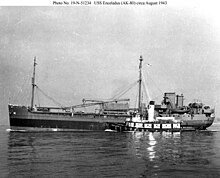|
Coastal trading vessel Coastal trading vessels, also known as coasters or skoots,[1] are shallow-hulled[citation needed] merchant ships used for transporting cargo along a coastline. Their shallow hulls mean that they can get through reefs where deeper-hulled seagoing ships usually cannot (26-28 feet), but as a result they are not optimized for the large waves found on the open ocean. Coasters can load and unload cargo in shallow ports. For European inland waterways, they are limited to a 33,49 m beam.[clarification needed]  World War II  During World War II there was a demand for coasters to support troops around the world. Type N3 ship and Type C1 ship were the designations for small cargo ships built for the United States Maritime Commission before and during World War II.[2][3] Both were use for close to shore and short cargo runs.[4][5][6] The Government of the United Kingdom used Empire ships type Empire F as merchant ships for coastal shipping. British seamen called these "CHANTs", possibly because they had the same hull form as Channel Tankers (CHANT); initially all the tankers were sold to foreign owners and therefore there was no conflict in nomenclature. The USA and UK both used coastal tankers also.[7][8][9] UK used Empire coaster tankers and T1 tankers. Many coasters had some armament, such as a 5-inch (127 mm) stern gun, 3-inch (76.2 mm) bow anti-aircraft gun and Oerlikon 20 mm anti-aircraft gun. These were removed after the war. After the war many of the ships were sold to private companies all around the world.[10][11] ShipyardsMajor coastal trading vessel shipyards include:[12]
See also
References
External linksWikimedia Commons has media related to Coastal motor vessels. Look up coaster in Wiktionary, the free dictionary. |